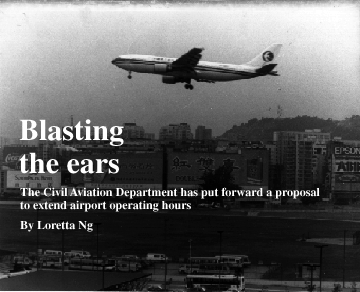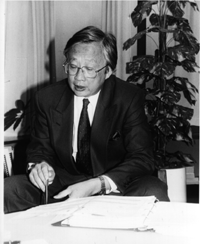
The proximity of the Hong Kong International Airport to residential areas is not only an unusual landuse design, but it also raises a social dilemma for the Hong Kong Government.
According to Mr. Howard Young, representative of the Legislative Council's Tourism Functional Constituency, millions of tourists who came to Hong Kong last year by air contributed $60 billion to the Gross domestic Product.
However, the airport capacity cannot satisfy the demand of tourism.
"Tourism demand for air trips alone has already exceeded the airport capacity. Yet the demand still grows 10 percent each year," Mr. Young said.
According to Mr. Peter Lok Kung Nam, director of the Civil Aviation Department added, "There are already 29 flights per hour programmed within the non-noise restricted hours."
Owing to the saturated capacity of the airport, applications for nearly 300 additional flights per week have been turned down. This will inevitably lead to economic loss.
Hoping to capture the potential gain, the Civil Aviation Department proposed increasing the utilization of the Hong Kong International Airport in two ways: increasing the number of scheduled aircraft movements during selected noise restricted hours, from 6:30 a.m. to 7 a.m. and 9 p.m. to 11:30 p.m.; and extending available scheduled times by one hour, from 11:30 p.m. to 12:30 p.m..
However, the proposed changes would further increase the noise nuisance generated by the aircraft.
In fact, noise pollution has been a long-standing headache in Kowloon City ever since the airport began operation.
A housewife living in Kowloon City for almost 30 years puts it this way:
"You don't care about the noise anymore since you have got used to being awakened up by the aircraft at night.
"We are just small potatoes in society. Who will consider our feelings?" she said bitterly.
The latest proposals have been condemned by some Urban Councillors.
Mr. Chan Kam Lam, member of the Democratic Alliance for the Betterment of Hong Kong, said that the government "has gone too far":
"Generally, normal ears can bear only 60 to 70 decibels. Long term exposure to noise exceeding this level will be harmful to both psychological and physiological health," he explained.
He cited a noise test done by the Alliance on December 30, 1994, at Kowloon City.
"The maximum noise level recorded was 101 decibels, while the average level was over 95 decibels.
"Also, a survey we conducted previously showed that 80 percent of interviewees opposed the new measures," Mr. Chan added.
"Is it fair to insist on carrying out a social policy while ignoring the needs and sufferings of the 250,000 residents?" Mr. Chan asked.
However, Mr. Lok did not totally side with Mr. Chan.
 |
| Mr. Lok Kung Nam, CAD director. |
|
On December 30, 1994, invited by the residents, Mr. Lok and Mr. Young spent one night on the fourth floor of Grace Evangelical Free Church at Kowloon City.
On the next day, Mr. Lok claimed that the noise generated by aircraft was "relatively acceptable".
Many people regarded this as a gesture for public relations purposes. They also blamed him for not bringing any noise-measuring devices for an objective measurement.
Mr. Lok denied that his night in Kowloon City was merely a show to draw media attention.
|
Said he: "I am not a noise professional. I went there simply to appreciate residents' views put across to me through the District Board.
"Besides, the Environmental Protection Department had already installed a measuring device on the roof of a school at Inverness Road under the flight path.
"The media urged me to tell my own perception. Yet, they just want me to say what they expected to hear.
"Frankly speaking, what wake me up is not the aircraft noise, but the obtrustive noise from the vehicle accelerations and some reporters," said Mr. Lok.
While explaining the rationale behind the proposal, Mr. Lok highlighted the benefit of the new adjustments:
"If we accept more flights, it will bring an additional $4.3 billion of tourist spending to Hong Kong."
He promised that the revenue will be used for the investments in tourism-related industries, like retail shops, hotels and restaurants.
"More air cargo can be carried by the aircraft as well. Therefore the export industry will also benefit from it," Mr. Lok added.
However, Mr. Chan was not satisfied with his answer.
"Though I appreciate his willingness to participate, his feeling can't reflect the seriousness of the problem," he said.
"I think he had better communicate more with the residents," Mr. Chan suggested.
The Pastor of Grace Evangelical Free Church who offered vacant flat for Mr. Lok and Mr. Young told the other side of the story.
"Mr. Lok and Mr. Young first held a press conference and later went to bed after 11 p.m., hence missing the noisiest period," he said.
Yet, Mr. Lok still saw some value in staying overnight.
"At least, this proved that I am not a mandarin (an official who turns a deaf ear to the public). I am just a public servant who reaches people and collects first-hand perceptions of what they suffer from day to night," he claimed.
Mr. Chan said that there is a need for compensation to the residents affected, this can be in form of rate exemptions or cash subsidies.
Mr. Lok welcomed the idea.
"I have expressed my attitude towards compensation, and the government is now considering it," said Mr. Lok.
However, Mr. Young did not regard compensation as a solution, as payment would continue endlessly and nothing would be improved.
Besides, Mr. Chan suggested the government try other alternatives before introducing the new measures.
In fact, he saw the latent capacity of Huang Tian Airport in Shenzhen in future developments.
"Huang Tian Airport can serve as a secondary airport to Hong Kong International Airport and help to alleviate the tremendous demands," said Mr. Chan.
Yet, Mr. Lok disagreed. "Huang Tian Airport is still at a developing stage and it cannot absorb all the unsatisfied demands immediately," he said.
Mr. Young had also tried to discuss with the airline industries improvements in flying technologies by using quieter aircrafts.
Nevertheless, both Mr. Lok and Mr. Young predicted that the proposal will be partially approved or approved in stages by the Executive Council after a consultation period.
Twenty-four hour operation is one extreme, while closing down Kai Tak Airport is another. No matter what the decision, it will be moot when the new airport opens, perhaps as early as 1997.
Extension of Hours
| Existing Operation | Proposed changes |
Programming hours | 6:30 a.m. to 11:30 p.m. | 6:30 a.m. to 12:30 a.m. |
Operating hours | 6 a.m. to midnight | 6 a.m. to 1 a.m. |
Increases in Movement
Time | Proposed new slots |
6:30 a.m. to 7 a.m. | 6 per day |
9 p.m. to 10:30 p.m. | 10 per day |
10:30 p.m. to 11:30 p.m. | 10 per day |
11:30 p.m. to 12:30 p.m. | 6 per day |
Source: Consultation Paper on Maximizing Capacity of Kai Tak Airport, Civil Aviation Department.
Return to contents

